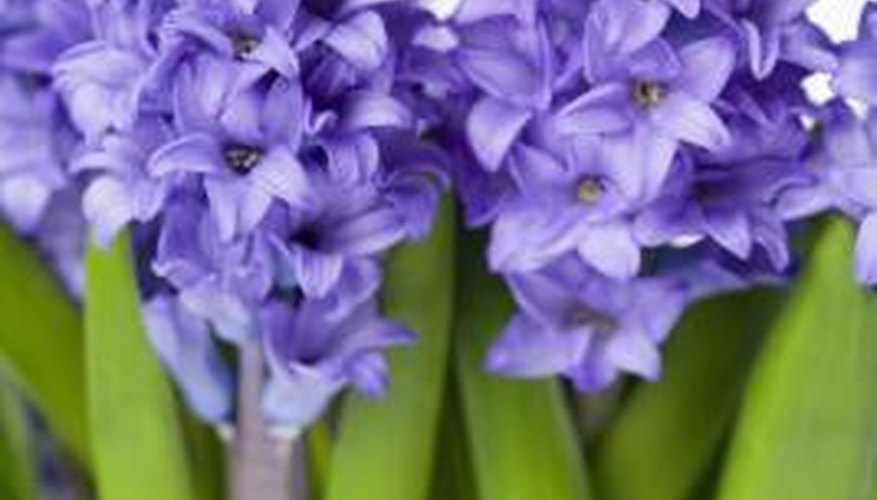Several plant species are referred to as hyacinths, and their tolerances to frosty temperatures vary. Among the most common hyacinths grown in the U.S. are the spring-blooming florist or Dutch hyacinth (Hyacinthus orientalis) and the grape hyacinth (Muscari spp.). Both are resistant to damage from light frosts, but a hard freeze can burn leaves and destroy any exposed flower petals. Water hyacinths (Eichhornia crassipes) turn yellow and brown after a frost.
Dutch Hyacinths
Because Dutch hyacinths sprout and bloom so early in spring, they are naturally adapted to chilly temperatures. These types of hyacinths, native to western Asia but bred in Holland, bloom around the same time as crocuses and early season daffodils, anywhere from late winter to mid-spring depending on climate. Dutch hyacinths with leaves and flower buds exposed are not harmed by temperatures as low as -3.89 degrees Celsius, lasting one hour. However, once petals open, some may dry out or drop away prematurely if temperatures drop below -1.67C for several hours. In general, do not worry about covering Dutch hyacinths when frosts occur with temperatures ranging from -1.11 to 1.66C. Do cover them if a hard freeze is expected overnight and you want to retain perfect flower clusters.
- Because Dutch hyacinths sprout and bloom so early in spring, they are naturally adapted to chilly temperatures.
- In general, do not worry about covering Dutch hyacinths when frosts occur with temperatures ranging from -1.11 to 1.66C.
- Do cover them if a hard freeze is expected overnight and you want to retain perfect flower clusters.
Grape Hyacinths
Grape hyacinths tend to bloom markedly later than Dutch hyacinths, so frosts and hard freezes usually are less of a concern. However, they are less resilient to frosts than Dutch varieties are. Expect grape hyacinths to bloom the same time as mid- and late-season daffodils and early season tulips. When the grasslike leaves of grape hyacinths pop up from the soil, they can handle temperatures down to -3.89C. Once flowers begin opening, it's best to shield them from temperatures below -1.67C. The delicate, bell-shaped blossoms blacken quickly if exposed to hard freezes and thick frost overnight. Flower buds may survive and then open with the return of warmth to replace the cold-killed blossoms lower on the flower spike.
- Grape hyacinths tend to bloom markedly later than Dutch hyacinths, so frosts and hard freezes usually are less of a concern.
- When the grasslike leaves of grape hyacinths pop up from the soil, they can handle temperatures down to -3.89C.
- Once flowers begin opening, it's best to shield them from temperatures below -1.67C.
- The delicate, bell-shaped blossoms blacken quickly if exposed to hard freezes and thick frost overnight.
Garden Location
Dutch and grape hyacinths planted in warm microclimates may need more monitoring and protection from hard freezes and frosts. Sunny hillsides and the southern or southwestern sides of house foundations and walls tend to warm up faster in late winter. This causes the bulbs to sprout earlier compared to the same plants out in an open field or garden bed. Hyacinths in the warm areas bloom earlier, so late frosts and freezes can be more harmful since more petals and plant tissues are above ground and exposed. Cover plants with fabric sheets as needed to shield them from temperatures below -2.22C.
- Dutch and grape hyacinths planted in warm microclimates may need more monitoring and protection from hard freezes and frosts.
- Hyacinths in the warm areas bloom earlier, so late frosts and freezes can be more harmful since more petals and plant tissues are above ground and exposed.
Water Hyacinths
Those with water gardens should not allow floating water hyacinths to be exposed to frost. A light frost shouldn't kill the plants, but can cause leaf yellowing, brown scalding and overall ugly plants. Water hyacinths should be taken outdoors in spring only once water temperatures get above 15.6C, which usually avoids weather that still provides subfreezing temperatures. In the fall, allow freezes and frost to kill water hyacinth, or bring the plants indoors to overwinter.
- Those with water gardens should not allow floating water hyacinths to be exposed to frost.
- In the fall, allow freezes and frost to kill water hyacinth, or bring the plants indoors to overwinter.
